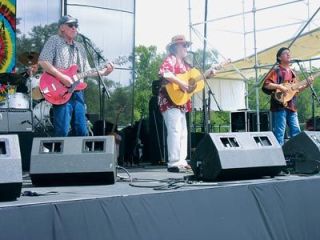ARLINGTON The 18th Annual Stillaguamish Festival of the River had already attracted more than 4,000 attendees, its total attendance from last year, to the River Meadows County Park by noon on its first day.
While the Aug. 11-12 event offered onlookers its characteristic mix of environmental education and relaxed entertainment in the summer sun, Stillaguamish Tribal Chair Shawn Yanity acknowledged that the presence of the Summer of Love concert tour had upped the ante.
We ordered 2,000 pounds of extra fish, just to be safe, said Yanity, sitting in the dunk tank. We always see people from all over anyway, who happen to be visiting Washington state and decide to stop by, said Yanity. There have been cars in our open field parking lot from North Carolina, California, Vermont, West Virginia, Louisiana and Florida. Last year, we even got some Japanese exchange students and a family from England.
Much of this diversity was reflected in the festivals pow wow, which likewise boasted more than 100 dancers, representing nearly as many Native American tribes across the country.
Weve got tribes here from the East Coast, the Great Lakes and the Great Plains, to down in the Southwest and up in Canada and Alaska, said pow wow announcer Arnold Little Head, a Sioux Indian living in Portland, Ore. Blackfoot, Chippewa, Crow, Cherokee, Choctaw, Puyallup, Seminole; theres literally too many to mention. Each region brings its own flavor and every year theres more and more of them, all drawn by the friendship and fellowship to be found at this gathering, which welcomes these people in a good way onto this land, to impart good will and share laughter, food and song.
The festivals organizers also hoped to impart to their guests a greater awareness of the local land and its issues. Pat Stevenson, environmental manager for the Stillaguamish Tribe, pointed out that the primary purpose of the festival has always been to promote the needs of the areas watershed among its residents.
They need to know about the state of the fish and wildlife populations and the water quality, not just here, but in other parts of the Puget Sound region, Stevenson said. As the urban sprawl develops and cities like Arlington and Stanwood grow, were shedding our forests.
Stevenson encouraged local citizens to take their surrounding environment into account, at home and at work, by adopting personal responsibility for the land and conserving water usage whenever theyre able to do so.
Especially if you live on the west side, dont worry so much about watering your lawn, because its going to rain, Stevenson said. Also, remember that the chemicals you use as pesticides and herbicides tend to get into the stream. Pets can contribute to a lot of the bacteria, because some of their owners think that if their dogs go to the bathroom outside, it just disappears. It ends up in the creek.
City of Arlington Natural Resources Director Bill Blake agreed with Stevenson that the festival adds to the general publics knowledge, not only of the steps they can take to protect and restore the watershed, but also of the groups and resources that are available to aid them in such aims.
It gives property owners a chance to meet the workers who help maintain the watershed, not so much as members of agencies, but as people, Blake said. We inform them of the work we do and how we do it. With the aerial maps in our booths, we can show them the names of the creeks and streams theyre living around and tell them what species are native to those areas.
Blake asserted that interactive features such as the salmon obstacle course for children and the logging show for all ages could further personalize environmental issues that might otherwise seem dry or distant to some spectators.
In the salmon obstacle course, kids have to make their way through a path of fishing nets, species of predators and other barriers, with only a few safe havens of logjams to protect them, said Blake of the staked-off loop of signs, nets and pipes. Even when adults see it, a light bulb turns on in their head about how difficult it is for these fish to survive. In much the same way, the logging show lets the loggers display skills they use in the field.
The music stage hosted performances not only from bands such as The Verve Pipe and Toad the Wet Sprocket, who have appeared in River Meadows County Park in previous years, but also Leroy Bell and his Only Friends and the reunited Jefferson Starship, making their debut at the Stillaguamish Festival of the River this year.
In the midst of tents of arts and crafts vendors and stands selling salmon, fried bread, snow-cones and homemade ice cream, the festivals dual themes of Native American heritage and environmental stewardship were echoed in almost all of its exhibits.
David Pehling, a Snohomish County extension assistant for Washington State University, has fascinated festival audiences for more than a decade with his demonstrations of flint knapping, chipping away at arrowheads using the techniques and tools that were common to the ancient ancestors of Native and non-Native Americans alike.
Kids in general often get interested in it, especially boys about 10-14 years old, but there are a lot of bigger kids who stay interested, said Pehling, clad in traditional Native American garb and telling tales from inside his own teepee. Im part of a Puget Sound area group of flint knappers with members in their 60s and 70s. They become intrigued by these artifacts from another culture and want to learn how to create the same things.
The Sarvey Wildlife Center, an Arlington-based non-profit organization devoted to the care and rehabilitation of injured and orphaned wild animals, brought an American kestrel, a peregrine falcon, a red-tailed hawk, a convocation of bald and golden eagles, and a parliament of barn, bard, and saw whet owls to the festival, while soliciting donations.
Weve been coming out here for a few years now and this is easily one of our favorite events of the year, said Jeff Guidre, a member of the Sarvey Wildlife Center Board of Directors. Its not like making presentations in the city. Everyone is amazed by how big and beautiful the animals are. I cant count the number of times Ive heard someone say, Ive never been this close to a bald eagle before.
Guidre summed up the groups message as follows.
You cant just save the animals, because you have to save the water and the trees that they live in too, said Guidre, who told younger onlookers, Once you grow up, youll be in charge of caring for the environment. If you dont do it, no one else will.
First-time attendee Sheri Lewis of Burlington traces her Native American heritage to Canada, and appreciates the festivals outreach to non-Native Americans.
A lot of non-Natives think theyre not invited to attend pow wows, even though they are, said Lewis, who plans to return with her two sons next year. Events like this make it comfortable to learn about other cultures.
I like the music and the salmon dinner, said Lewis 9-year-old son, Jered Brown.
Tari Bosley had attended the festival with her husband and four children last year, and enjoyed it so much that she brought two of her friends children this year.
Its great, especially for the younger kids, to learn a little history, Bosley said. Plus, its so family-oriented and free.
Its been really interesting to see different cultures, said Bosleys 16-year-old son Aaron. Besides, I like being outdoors.
Dwayne and Melissa Wendt have been attending the festival for at least a decade, but they didnt realize the event was so open at first.
We live just up the hill from here, said Melissa Wendt, who attended with her husband Dwayne, their son Kirby and their friend Heather Hottinger. We used to think we were sneaking in, until we found out it was free. It still feels like its in our backyard.
My husband went to the Meltdown, but I had to come here, Hottinger said. Its much more intimate, and the salmon dinner cant be beat.
The folks who run this do a great job, said Dwayne Wendt.
This is definitely one of our biggest outreach programs, Stevenson said. Throughout the year, we get phone calls from citizens about various projects or problems, as a result of the connections that the locals make and the interactions they have with the Tribe at this festival. If we were just a bunch of booths in a field, with the bands or the logging shows, we wouldnt attract nearly as many people.
Stilly Festival of River draws diverse crowds for weekend of entertainment, education
ARLINGTON The 18th Annual Stillaguamish Festival of the River had already attracted more than 4,000 attendees, its total attendance from last year, to the River Meadows County Park by noon on its first day.








